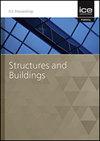Numerical simulation of damaged reinforced concrete half-joint beams: towards appraisal and retrofitting
IF 1.4
4区 工程技术
Q3 CONSTRUCTION & BUILDING TECHNOLOGY
Proceedings of the Institution of Civil Engineers-Structures and Buildings
Pub Date : 2022-04-20
DOI:10.1680/jstbu.21.00004
引用次数: 2
Abstract
Half-joint concrete beams are characterized by local reductions in the overall beam depth at the support and are ideal for structural connections. The beam joint region is however vulnerable for deterioration and for design/detailing shortcomings. This study explored the nonlinear numerical modelling potential of the behaviour of a series of impaired half-joint beams. The major defects were: diagonal-bar/ U-bar unavailability; shear reinforcement inadequacy; and reinforcement corrosion. The results highlighted the numerical simulation capabilities to capture global/local behaviours of the beam series. The load capacity prediction offset was in an impressive range of −16.7% to +1.5% and, in contrast, the predictions from the commonly used strut-and-tie model (STM) showed offsets in the extent of −39.2% to 16.9%. Subsequently, an experimental study was established using the FE model to explore the retrofitting potential of defective half-joint beams with a deep embedded (DE) technique. The strength enhancement was almost 30% and the internal load paths as well as the failure mode of the defective beam alternated favourably with the post-installation of the retrofitting element. Thus, the DE technique was identified to be an ideal option to retrofit impaired half-joint beams.钢筋混凝土半缝梁损伤的数值模拟:评估与改造
半接缝混凝土梁的特点是在支撑处整体梁深的局部减小,是结构连接的理想选择。然而,梁节点区域很容易恶化和设计/细节缺陷。本研究探讨了一系列受损半接缝梁的非线性数值模拟潜力。主要缺陷是:无对角线棒/ u形棒;抗剪配筋不足;和钢筋腐蚀。结果强调了数值模拟能力,以捕捉光束系列的全局/局部行为。载荷能力预测偏差在- 16.7%至+1.5%的范围内,相比之下,常用的支柱-拉杆模型(STM)的预测偏差在- 39.2%至16.9%的范围内。随后,利用有限元模型建立了一项实验研究,探讨了深度嵌入技术对缺陷半接缝梁的改造潜力。强度提高了近30%,内部荷载路径以及缺陷梁的破坏模式随着改造单元的安装而发生了有利的变化。因此,DE技术被认为是修复受损半关节梁的理想选择。
本文章由计算机程序翻译,如有差异,请以英文原文为准。
求助全文
约1分钟内获得全文
求助全文
来源期刊
CiteScore
3.40
自引率
6.20%
发文量
61
审稿时长
12 months
期刊介绍:
Structures and Buildings publishes peer-reviewed papers on the design and construction of civil engineering structures and the applied research associated with such activities. Topics include the design, strength, durability and behaviour of structural components and systems.
Topics covered: energy conservation, people movement within and around buildings, strength and durability of steel and concrete structural components, and the behaviour of building and bridge components and systems

 求助内容:
求助内容: 应助结果提醒方式:
应助结果提醒方式:


